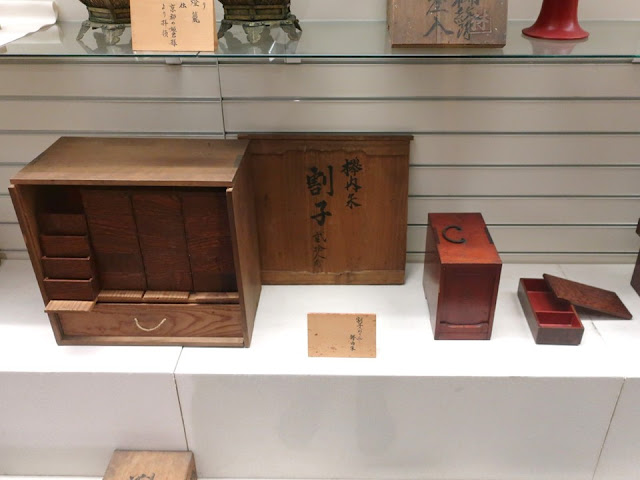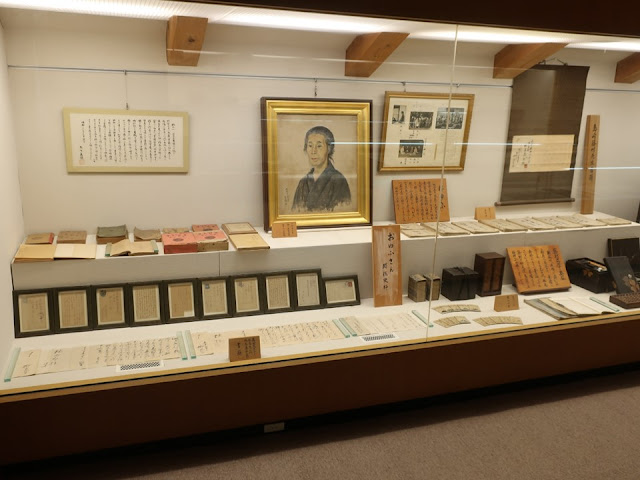The museum is in a popular ex-post-town “Tsumago” on Nakasendou highway which linked Edo (old name of Tokyo) and Kyoto. It is in Nagano prefecture of central Japan.
“Tsumago” is famous for its well-preserved
street. The museum consists of three buildings.
博物館がある中山道妻籠宿は、古い街並みが保存され、旧街道屈指の観光地になっています。博物館として公開されている三施設を訪問しました。
Waki-Honjin Okuya、脇本陣奥谷
The entrance of the museum is on the left. It was an inn classified “Waki-Honjin”. In the case “Honjin”, which was dedicated inn for daimyo lord and so on, was full, they stayed at “Waki-Honjin”. The inn was called “Okuya”. We can enter the building. Okuya’s valuables are displayed at the ex-storehouse. Although it is not fun of ordinary people (theme of my blog), we can find fun of wealthy family to own classy items.
左が南木曽町博物館の入口です。脇本陣を務めていた奥谷(屋号)が公開され、土蔵を利用した資料室では名家らしい品々が展示されています。庶民の楽しみとはいえませんが、良い品をもつ楽しみがありますね。
The building was constructed in 1877. Japanese cypress was used abundantly, which had not been permitted for people to use then in the Edo period (1603~1868) when shogun had ruled Japan. It was rebuilt as a residence (not as an inn) because the post-town system had been abolished after the Edo period. Afterward, the building was donated to the town. The owner (Hayashi family) still lives nearby.
1877(明治10)年に宿ではなく住宅として建て替えられました。明治になって一般人も使えるようになった木曽檜がふんだんに用いられています。明治期は酒造で栄えましたが、昭和恐慌で廃業しました。屋敷は町に寄付され、所有者の林家は近くに住んでいらっしゃるそうです。
There is an earthen floor behind the entrance door, and is an irori fire place on its right. A master put his feet on the board in the irori, so he could warm his feet. I tried it; it’s true. The oldest son sat next to the master. The housewife sat on the right side of the irori. The guide removed the straw mat and explained, “Only those three could sat on mat. The other family member sat on the wooden floor. They experienced hardships in order to prepare for independence from the family in the future.”
玄関を入ると土間があり、その右側に囲炉裏があります。囲炉裏の中の木は主人が足を置く場所です。確かに暖かい。隣は長男、右側は主婦の席です。板の間のゴザは、上記の三人しか敷けず、嫁とやがて家を出る子どもたちは板の間に座って、苦労を味わい将来に備えたそうです。案内の方がゴザを持ち上げて説明してくれました。
The sunbeam through the lattice on south is fantastic; it is reflected in the smoke from irori. The guide said that the view was designed by a carpenter. The family sat down by the irori, looked at the light, felt the time passing and enjoyed life. It was a rich time, I think.
南側の格子から差し込む光が、囲炉裏からの煙に反射して幻想的です。パンフレットに載っている眺めで、大工さんが意図的に作ったとのことでした。光を見て、時間を感じて、日々を楽しむ。贅沢な時間ですね。
There are guestrooms next to the irori room (living and dining room). The inner most room is for high-ranking guests. The emperor took a break in 1880. Glasses are put in the sliding doors (shoji), so you can see the garden. It’s picturesque! Dedicated gate and entrance were built for guests.
囲炉裏の部屋の隣は、客用の座敷です。一番奥は上段の間。明治13年に天皇が休息されました。雪見障子からは苔の庭が見え、絵のようです。専用の門と式台が作られています。
The emperor’s photo and picture of the procession are displayed. The envelope was given to the owner; 15 yen was in it. The emperor wore boots, when he got into the rooms; red carpets were laid.
明治天皇が巡幸されたときの絵と、下賜された金15円の包み紙です。天皇は、長靴のまま、赤絨毯を敷いた座敷に上がったそうです。
The family run a sake brewery. The exhibits were used back then. The party looks so joyful. Btw, maids lived the room; it is dark and small.
酒造業を営んでいた時の品々です。宴会の絵は楽しそう。この部屋は女中部屋でした。狭い。
I walked to the fireproof storehouse, which is a museum now.
奥の土蔵・脇本陣奥谷資料室へ向かいます。
Treasures of the family are displayed. The stairs in the left were also used as storage.
林家のお宝が陳列されています。左側の階段が、箱階段。活用されています。
Classy utensils used while serving or drinking sake are displayed.
良さそうな酒器が並びます。
I close-up my favorites; a large set of meal boxes (left) and a small one.
展示ケース最下段の割子(左、重箱)と手提げ重か弁当箱(右)のアップです。
It is a still to make shochu (distilled spirits). I think it’s rare to drink not only sake (brewed liquor) but also shochu back then. The funny picture is on it.
焼酎蒸留具も展示されています。焼酎も飲んだのですね。おどけた絵が描かれているように見えます。
The woman in center got married with the family member and lived in the residence. She was a childhood friend of a famous author (Shimazaki Touson, 1872-1943). Items related to them are exhibited. His masterpiece is “Hatsukoi” (first love), which is my favorite poem.
林家に嫁入りしたゆふさんは、島崎藤村の幼なじみで、「初恋」にうたわれた人とされています。「まだあげ初めし前髪の 林檎のもとに見えしとき 前にさしたる花櫛の 花ある君と思ひけり」、中高生の頃、キュンときた詩でした(七五調がよいところなので英訳できませんでした)。ゆかりの品々が展示されています。
All items were her belongings. The folding screen was a gift from the author.
ゆふさんの所有物です。屏風は、藤村からゆふさんに送られたものです。
The table above is a ranked list of restaurants in Tokyo in 1865. They interested in restaurants faraway. What gourmet people they were!
江戸の料理屋の番付もありました。江戸の店もチェックしていたのですね。1865年のもののようです(参考:https://www.syokubunka.or.jp/publication/gallery/nishikie/detail/post155.html)。
Well-read books are exhibited, which shows their interest in cultured hobby. They lived at the major highway bask then, that’s why they could easily get books.
読み込まれた里見八犬伝(全百冊)などが展示されています。知の楽しみですね。流通経路である街道筋は物を手に入れやすいです。
The caption says, “A book for writing love letter”.
恋文の書き方の本もありました。
Official
website: http://nagiso-museum.jp/museum.html
(in Japanese)
Visited in March, 2024
Previous post (museum in the neighboring village
and two post-towns on Nakasendou highway): Okuwa
history and folklore museum、大桑村歴史民俗資料館
Next post (part2 of this article): Nagiso-machi Museum in Tsumago (2/2)、南木曽町博物館(part2)


















Comments
Post a Comment